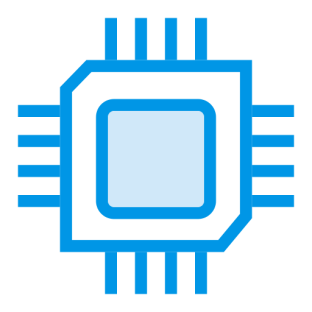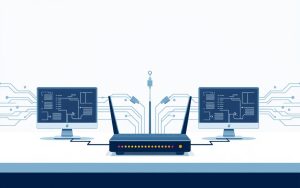Data networks are complex systems that allow digital information to flow between computing devices. They form the backbone of modern communication, linking billions of devices across the globe. These networks enable smooth data transfer through various technological platforms.
The concept of data networks has evolved since the late 1960s. It started with ARPANET and has grown into today’s intricate global systems. These technological ecosystems have transformed how we share information and communicate.
Data networks come in different shapes and sizes. They include Local Area Networks (LANs), Wide Area Networks (WANs), and cellular networks. These systems use advanced technologies like packet switching for fast and reliable data transmission.
Many industries rely on robust data network structures. Telecommunications, internet services, and business communication systems all depend on these networks. They support everything from personal device connectivity to complex organizational communication setups.
As data networks grow, they drive technological progress. They pave the way for more advanced methods of sharing information. These networks continue to improve global connectivity and communication.
Understanding Data Networks: Basic Concepts and Definition
Data networks connect billions of devices worldwide. They enable seamless information exchange across various technological platforms. These complex systems form the backbone of modern digital communication.
Network architecture helps organizations optimize their digital infrastructure. It also improves communication strategies. Understanding these concepts is crucial for effective implementation.
The fundamental components of data network architecture include:
- Nodes (computers, servers, routers)
- Communication links (wired and wireless connections)
- Network protocols (like TCP/IP)
- Transmission lines
- Access points
Components of Data Network Architecture
Data network components work together for efficient data transmission. Nodes serve as connection points in the network. Communication links provide pathways for information transfer.
Protocols are the most critical element. They define how data packets are sent and received across the network.
Role of Data Networks in Modern Computing
Modern computing depends on data networks for resource sharing and communication. They enable organizations to share hardware resources and access centralized databases.
Data networks also facilitate remote collaboration. They support global communication, connecting people and businesses worldwide.
Network Access Points and Transmission Lines
Network access points allow devices to join and communicate within the network. They act as connection interfaces for various devices.
Transmission lines carry data packets across different geographical locations. These can be fiber optic, copper, or wireless. They ensure rapid and reliable information exchange.
Types of Data Networks and Their Applications

Data networks are vital for modern digital communication. They come in various scales and serve unique technological needs. Understanding network types helps optimize communication strategies.
The main network types include:
- Personal Area Network (PAN): Connects devices within a personal workspace, typically ranging 1-100 meters
- Local Area Network (LAN): Interconnects devices within limited areas like offices or buildings
- Metropolitan Area Network (MAN): Covers larger urban regions, connecting multiple buildings
- Wide Area Network (WAN): Spans extensive geographical distances, including global internet connections
Each network type has unique features for speed, range, and use. LANs offer fast connections around 100 Mbps, perfect for offices. MANs cover 5-50 kilometers, supporting city-wide communication.
WANs enable global data transmission, linking multiple LANs across vast regions. Choosing a network depends on specific communication needs.
Factors to consider include:
- Geographic coverage needed
- Transmission speed requirements
- Initial setup and maintenance costs
- Security considerations
Organizations use these networks to create strong, flexible communication systems. These systems support teamwork, resource sharing, and smooth data exchange across different scales.
Data Transmission Methods and Protocols
Network communication uses complex methods to transfer data across digital landscapes. These methods enable seamless connectivity between devices. They transform how information moves through modern technological ecosystems.
Data transmission uses sophisticated approaches for moving information across networks. The two main methods are circuit switching and packet switching. Each method impacts data transfer efficiency differently.
Circuit Switching vs Packet Switching
Circuit switching creates a dedicated channel between sender and receiver. It reserves full bandwidth for the entire transmission. Packet switching breaks data into smaller packets for independent routing.
- Circuit Switching: Guarantees consistent bandwidth
- Packet Switching: Optimizes network resource utilization
- Enables more flexible and efficient data transmission
TCP/IP Protocol Suite
The TCP/IP protocol suite is the backbone of internet communication. This system has four key layers that work together. They ensure reliable data transfer across networks.
- Network Access Layer
- Internet Layer
- Transport Layer
- Application Layer
Data Flow and Communication Patterns
Data transmission uses various communication patterns. These include simplex, half-duplex, and full-duplex modes. These patterns control how information exchanges between network endpoints. They offer flexibility in data communication strategies.
Modern networks can accommodate billions of devices, showcasing the scalable design of TCP/IP protocols.
What Is Data Network in Computer
A data network is a complex system that links computers and devices. It allows smooth information sharing. These networks form the foundation of global communication, connecting devices across various platforms.
Data network basics include key parts for effective communication. Network interfaces connect devices. Transmission protocols standardize communication. Routing systems manage data packets. Security measures protect information flow.
Different network types serve specific purposes. Local Area Networks (LANs) link devices in small areas like offices. Metropolitan Area Networks (MANs) cover larger urban regions. Wide Area Networks (WANs) support global communication.
Data networks have changed how we interact. They started with ARPANET in the 1960s. Now, the internet connects billions of devices worldwide. These networks enable file sharing and cloud computing services.
Network Infrastructure and Components
Network infrastructure is the backbone of modern digital communication. It connects various devices and hardware components for seamless data transmission. These complex systems enable information flow across different environments, from small local networks to global systems.
Key network devices in this infrastructure include:
- Routers: Direct data packets between different networks
- Switches: Connect devices within a single network
- Firewalls: Provide security by controlling network traffic
- Wireless Access Points: Enable wireless device connectivity
- Network Interface Cards: Allow devices to communicate on a network
Network hardware complexity varies based on scale and purpose. Local Area Networks (LANs) cover smaller areas like schools or offices. Wide Area Networks (WANs) can span entire countries or continents.
A typical wireless access point can connect hundreds of users. However, practical capacity might be lower in real-world situations.
Modern networks are the digital highways that connect our world, transforming how we communicate, work, and share information.
Effective network infrastructure design requires careful planning. Factors to consider include topology, performance, scalability, and security. The right mix of devices ensures reliable data transmission across various settings.
New technologies are changing network infrastructure. IoT and cloud computing drive innovation in how we connect and communicate. The future of networking focuses on creating smarter, adaptive, and secure components.
Benefits and Applications of Data Networks
Data networks have changed how we communicate and work together. These advanced network applications offer powerful features across many areas. They help people and businesses share information easily.
Modern data networks do more than just connect devices. They help businesses work better and faster. Organizations use these systems to improve their operations.
Resource Sharing Capabilities
Data networks make sharing resources simple. They use advanced technology to do this.
Some key benefits include central file storage and shared network printers. They also allow easy software distribution and efficient data sharing across locations.
Communication Enhancement
Digital communication platforms have changed how we interact. Data networks now support many new ways to communicate.
These include video calls, instant messaging, and global email. They also offer tools for working together on projects.
Cost-Efficiency Advantages
Data networks help save money by cutting down on equipment costs. They also make work more efficient.
Smart network design lets businesses do more with less hardware. This helps them get the most out of their technology.
The future of business communication relies on robust, scalable data network infrastructures.
Advanced network technologies open up new possibilities. They help businesses grow, work together, and come up with new ideas.
Conclusion
Data networks have revolutionized digital communication. They’ve grown from simple connections to complex, multi-path systems. Future networks will use advanced tech for better data transmission.
Modern network infrastructure supports complex designs. These networks can adapt to new tech demands. They scale up easily to meet changing needs.
Network trends are pushing limits with software-defined networking. Enterprise networks now use overlay networks for flexible data transmission. Cloud services like AWS have changed network design.
Organizations can now create flexible, scalable network environments. These networks adjust to operational needs on the fly. This adaptability is crucial in today’s fast-paced digital world.
Security is a top priority in network development. New solutions have built-in encryption and access control. They also include advanced monitoring capabilities for better protection.
VPNs and advanced security protocols are becoming standard. These features ensure data safety across complex network structures. They’re essential for maintaining trust in digital communications.
The future of data networks looks promising. Technologies like 5G and AI will drive further evolution. New management strategies will create smarter, more responsive networks.
These advancements aim to support our growing digital needs. They’ll build more secure and efficient network ecosystems. This will help meet the challenges of our increasingly connected world.







